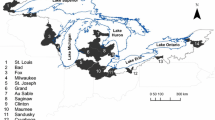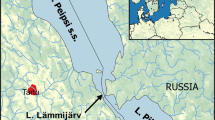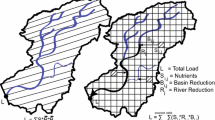Abstract
Changes in fertilizer use, manure management or precipitation may alter the frequency of episodes of high nutrient runoff and thereby affect annual nutrient loads and total nutrient concentrations of lakes. We developed an empirical, stochastic model for daily P loads and used the model to project annual P loads and summer total P concentrations in Lake Mendota, Wisconsin, USA. Daily P loads (8,250 daily observations) were fit closely by a three-part gamma distribution composed of days with low, intermediate, and high P loads. High P load days happen when heavy rains or snowmelt occur on soil with abundant P, often as a result of manure or inorganic fertilizer application. In Lake Mendota, on average 29 days per year accounted for 74 % of the annual load. Simulations showed that median annual P loads increased linearly with the frequency of high P load days. However, the upper quantiles of the annual P load distribution increased more steeply than the median. Increases in the number of high P load days per year also increased summer concentrations of P in the lake. Thus increases in the frequency of high P load days due to larger precipitation events or increased application of fertilizers and manure may worsen widespread problems caused by P pollution of lakes in this agricultural watershed.






Similar content being viewed by others
References
Bennett EM, Reed-Andersen T, Houser JN, Gabriel JR, Carpenter SR (1999) A phosphorus budget for the lake Mendota watershed. Ecosystems 2(1):69–75
Bennett EM, Carpenter SR, Clayton MK (2005) Soil phosphorus variability: scale-dependence in an urbanizing agricultural landscape. Landsc Ecol 20(4):389–400. doi:10.1007/s10980-004-3158-7
Boni G, Parodi A, Rudari R (2006) Extreme rainfall events: learning from raingauge time series. J Hydrol 327(3–4):304–314. doi:10.1016/j.jhydrol.2005.11.050
Burnham KP, Anderson DR (1998) Model selection and inference. Springer, New York
Canfield DE Jr, Bachmann RW (1981) Prediction of total phosphorus concentrations, chlorophyll a, and secchi depths in natural and artificial lakes. Can J Fish Aquat Sci 38(4):414–423. doi:10.1139/f81-058
Carlson RE (1977) A Trophic State Index for lakes. Limnol Oceanogr 22(2):361–369
Carpenter SR, Lathrop RC (2014) Phosphorus loading, transport and concentrations in a lake chain: a probabilistic model to compare management options. Aquat Sci 76(1):145–154. doi:10.1007/s00027-013-0324-5
Carpenter SR, Caraco NF, Correll DL, Howarth RW, Sharpley AN, Smith VH (1998) Nonpoint pollution of surface waters with phosphorus and nitrogen. Ecol Appl 8(3):559–568. doi:10.1890/1051-0761(1998)008[0559:NPOSWW]2.0.CO;2
Carpenter SR, Lathrop RC, Nowak P, Bennett EM, Reed T, Soranno PA (2006) The ongoing experiment: restoration of Lake Mendota and its watershed. In: Magnuson JJ, Kratz TK, Benson BJ (eds) Long-term dynamics of lakes in the landscape. Oxford University Press, London
Carpenter SR, Stanley EH, Vander Zanden MJ (2011) State of the world’s freshwater ecosystems: physical, chemical, and biological changes. Annu Rev Environ Resour 36(1):75–99. doi:10.1146/annurev-environ-021810-094524
Caspers H (1984) OECD: Eutrophication of Waters. Monitoring, Assessment and Control—154 pp. Paris: Organisation for Economic Co-Operation and Development 1982. (Publié en français sous le titre » Eutrophication des Eaux. Méthodes de Surveillance, d’Evaluation et de Lutte «). Internationale Revue der gesamten Hydrobiologie und Hydrographie 69(2):200. doi:10.1002/iroh.19840690206
Dhillon GS, Inamdar S (2013) Extreme storms and changes in particulate and dissolved organic carbon in runoff: entering uncharted waters? Geophys Res Lett 40(7):1322–1327. doi:10.1002/grl.50306
Duan W, Takara K, He B, Luo P, Nover D, Yamashiki Y (2013) Spatial and temporal trends in estimates of nutrient and suspended sediment loads in the Ishikari River, Japan, 1985 to 2010. Sci Total Environ 461–462:499–508. doi:10.1016/j.scitotenv.2013.05.022
Eghball B, Gilley JE, Baltensperger DD, Blumenthal JM (2002) Long-term manure and fertilizer application effects on phosphorus and nitrogen in runoff. Trans Am Soc Agric Biol Eng 45:687–694
Gabriele S, Arnelle N (1991) A hierarchical approach to regional flood frequency analysis. Water Resour Res 27(6):1281–1289
Gassman PW, Reyes MR, Green CH, Arnold JG (2007) The soil and water assessment tool: historical development, applications, and future research directions. Trans Am Soc Agric Biol Eng 50:1211–1250
Gelman A, Carlin JB, Stern HS, Rubin DB (2004) Bayesian data analysis. Chapman and Hall, New York
Gentry LE, David MB, Royer TV, Mitchell CA, Starks KM (2007) Phosphorus transport pathways to streams in tile-drained agricultural watersheds. J Environ Qual 36(2):408–415. doi:10.2134/jeq2006.0098
Gonzalez-Hidalgo JC, Batalla RJ, Cerda A (2013) Catchment size and contribution of the largest daily events to suspended sediment load on a continental scale. Catena 102:40–45. doi:10.1016/j.catena.2010.10.011
Haygarth PM, Jarvis SC (1997) Soil derived phosphorus in surface runoff from grazed grassland lysimeters. Water Res 31(1):140–148. doi:10.1016/s0043-1354(99)80002-5
Jennings E, Jones S, Arvola L, Staehr PA, Gaiser E, Jones ID, Weathers KC, Weyhenmeyer GA, Chiu C-Y, De Eyto E (2012) Effects of weather-related episodic events in lakes: an analysis based on high-frequency data. Freshw Biol 57(3):589–601. doi:10.1111/j.1365-2427.2011.02729.x
Kara E, Heimerl C, Killpack T, Van de Bogert M, Yoshida H, Carpenter S (2011) Assessing a decade of phosphorus management in the Lake Mendota, Wisconsin watershed and scenarios for enhanced phosphorus management. Aquat Sci 74:241–253. doi:10.1007/s00027-011-0215-6
Katz RW, Brush GS, Parlange MB (2005) Statistics of extremes: modeling ecological disturbances. Ecology 86(5):1124–1134. doi:10.1890/04-0606
Kollu R, Rayapudi SR, Narasimham S, Pakkurthi KM (2012) Mixture probability distribution functions to model wind speed distributions. Int J Energy Environ Eng 3(1):27
Kucharik CJ, Serbin SP, Vavrus S, Hopkins EJ, Motew MM (2010) Patterns of climate change across Wisconsin from 1950 to 2006. Phys Geogr 31(1):1–28. doi:10.2747/0272-3646.31.1.1
Kunkel KE, Karl TR, Easterling DR (2007) A Monte Carlo assessment of uncertainties in heavy precipitation frequency variations. J Hydrometeorol 8(5):1152–1160. doi:10.1175/jhm632.1
Lathrop RC (2007) Perspectives on the eutrophication of the Yahara lakes. Lake Reserv Manag 23:345–365
Lathrop RC, Carpenter SR (1992) Phytoplankton and their relationship to nutrients. In: Kitchell JF (ed) Food web management: a case study of Lake Mendota, Wisconsin. Springer, New York, pp 99–128
Lathrop RC, Carpenter SR (2014) Water quality implications from three decades of phosphorus loads and trophic dynamics in the Yahara chain of lakes. Inland Waters 4:1–14
Lathrop RC, Carpenter SR, Rudstam LG (1996) Water clarity in Lake Mendota since 1900: responses to differing levels of nutrients and herbivory. Can J Fish Aquat Sci 53(10):2250–2261. doi:10.1139/f96-187
Lathrop RC, Carpenter SR, Stow CA, Soranno PA, Panuska JC (1998) Phosphorus loading reductions needed to control blue-green algal blooms in Lake Mendota. Can J Fish Aquat Sci 55(5):1169–1178. doi:10.1139/f97-317
Lathrop RC, Carpenter SR, Robertson DM (1999) Summer water clarity responses to phosphorus, Daphnia grazing and intermal mixing in Lake Mendota. Limnol Oceanogr 44:137–146
McCullough GK, Page SJ, Hesslein RH, Stainton MP, Kling HJ, Salki AG, Barber DG (2012) Hydrological forcing of a recent trophic surge in Lake Winnipeg. J Great Lakes Res 38(3(0)):95–105. doi:10.1016/j.jglr.2011.12.012
Miller WP, DeRosa GM, Gangopadhyay S, Valdes JB (2013) Predicting regime shifts in flow of the Gunnison River under changing climate conditions. Water Resour Res 49:1–9. doi:10.1002/wrcr.20125
Oeurng C, Sauvage S, Coynel A, Maneux E, Etcheber H, Sánchez-Pérez J-M (2011) Fluvial transport of suspended sediment and organic carbon during flood events in a large agricultural catchment in southwest France. Hydrol Process 25(15):2365–2378. doi:10.1002/hyp.7999
Peterson TC, Zhang X, Brunet-India M, Vazquez-Aguirre JL (2008) Changes in North American extremes derived from daily weather data. J Geophys Res-Atmospheres 113 (D7). doi:10.1029/2007jd009453
Pionke HB, Gburek WJ, Sharpley AN, Schnabel RR (1996) Flow and nutrient export patterns for an agricultural hill-land watershed. Water Resour Res 32(6):1795–1804. doi:10.1029/96wr00637
Pitt R, Voorhees J (2002) SLAMM, the source loading and management model. In: Field R, Sullivan D (eds) Wet-weather flow in the Urban Watershed: technology and mangement. CRC Press, Boca Raton, pp 103–139
R Development Team (2012) R: a language and environment for statistical computing. R Foundation for Statistical Computing, Vienna
Rossi F, Fiorentino M, Versace P (1984) Two component extreme value distribution for flood frequency analysis. Water Resour Res 20:847–856
Royer TV, David MB, Gentry LE (2006) Timing of riverine export of nitrate and phosphorus from agricultural watersheds in Illinois: implications for reducing nutrient loading to the Mississippi River. Environ Sci Technol 40(13):4126–4131. doi:10.1021/es052573n
Sharpley AN, Kleinman PJA, Flaten DN, Buda AR (2011) Critical source area management of agricultural phosphorus: experiences, challenges and opportunities. Water Sci Technol 64(4):945–952. doi:10.2166/wst.2011.712
Stow CA, Carpenter SR, Lathrop RC (1997) A Bayesian observation error model to predict cyanobacterial biovolume from spring total phosphorus in Lake Mendota, Wisconsin. Can J Fish Aquat Sci 54(2):464–473. doi:10.1139/f96-279
Vavrus S, Van Dorn J (2010) Projected future temperature and precipitation extremes in Chicago. Journal of Great Lakes Research 36, Supplement 2(0):22–32. doi:10.1016/j.jglr.2009.09.005
Villarini G, Smith JA, Baeck ML, Vitolo R, Stephenson DB, Krajewski WF (2011) On the frequency of heavy rainfall for the Midwest of the United States. J Hydrol 400(1–2):103–120. doi:10.1016/j.jhydrol.2011.01.027
Villarini G, Smith JA, Vecchi GA (2013) Changing Frequency of Heavy Rainfall over the Central United States. J Clim 26(1):351–357. doi:10.1175/jcli-d-12-00043.1
White PJ, Hammond JP (2009) The sources of phosphorus in the waters of Great Britain. J Environ Qual 38(1):13–26. doi:10.2134/jeq2007.0658
Acknowledgments
This research was supported by NSF through the Water Sustainability and Climate program (Grant #DEB-1038759) and the North Temperate Lakes LTER site, and by the Wisconsin Department of Natural Resources.
Author information
Authors and Affiliations
Corresponding author
Rights and permissions
About this article
Cite this article
Carpenter, S.R., Booth, E.G., Kucharik, C.J. et al. Extreme daily loads: role in annual phosphorus input to a north temperate lake. Aquat Sci 77, 71–79 (2015). https://doi.org/10.1007/s00027-014-0364-5
Received:
Accepted:
Published:
Issue Date:
DOI: https://doi.org/10.1007/s00027-014-0364-5




